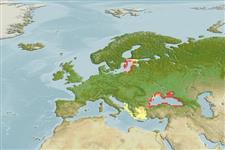Common names from other countries
>
Gobiiformes (Gobies) >
Gobiidae (Gobies) > Gobiinae
Etymology: Neogobius: Greek, neos = new + Latin, gobius = gudgeon (Ref. 45335).
More on author: Pallas.
Environment: milieu / climate zone / depth range / distribution range
Ecologia
marinhas; Água doce; estuarina demersal; anfídromo (Ref. 46888); intervalo de profundidade 0 - 30 m (Ref. 36771). Temperate; 4°C - 20°C (Ref. 2059); 60°N - 36°N, 18°E - 58°E
Europe and Asia: Sea of Azov, Black Sea and Caspian basins. Adverse ecological impact after introduction have been reported by several countries. In 2004, this was accidentally introduced in North America with ballast water in ships (Ref. 59043).
Comprimento de primeira maturação / Tamanho / Peso / Idade
Maturity: Lm ?, range 4 - ? cm
Max length : 35.0 cm TL macho/indeterminado; (Ref. 88073); peso máx. publicado: 381.42 g (Ref. 88073); idade máx. registrada: 6 anos (Ref. 110985)
Descrição suscinta
Chaves de identificação | Morfologia | Morfometria
Espinhos dorsais (total) : 7 - 8; Raios dorsais (total) : 12 - 17; Espinhos anais: 1; Raios anais : 9 - 14; Vértebras: 31 - 34. This species is distinguished from its congeners entering freshwater in Europe by the following characters: first branched ray of second dorsal about as long as penultimate ray; no scales on midline of nape, in front of preoperculum; pelvic-disc fraenum with small rounded lobes and the length is less than 1/6 of width at base; scales in midlateral series 45-54 + 2-3; a large black spot on the posterior part of first dorsal (Ref. 59043).
Prefer shallow, brackish waters but also occur in fresh waters (Ref. 36771); in lagoons and lakes, large rivers, harbors, on sand or rock bottom; mostly found on well vegetated or rock bottom (Ref. 59043). Can tolerate a temperature range of 0 to 30°C, but mainly thrive in warm
temperate waters; able to tolerate low oxygen content waters for several days (Ref. 36771). Oviparous, with demersal eggs (Ref. 36771). Longevity up to 4 years. Males reproduce for the first time at 3-4 years, females at 2-3 years. Spawning season in April to September; females may repeat spawning during a season, every 18-20 days; body of males entirely black during this season. Adhesive eggs deposited on stones, shells and aquatic plants; males guard eggs until hatching and usually die after spawning season. Egg clutches are supposed to be occasionally transported attached to the hull of ships, facilitating introduction to other areas. Feeds on a wide variety of invertebrates and small fish, mostly on molluscs (Ref. 59043). Due to its large size, it has a major commercial value in some areas, especially in Azov Sea. It is usually salted, dried and consumed with beer (Ref. 92840).
Males protect embryos and juveniles (Ref. 36771). Males die after the spawning season (Ref. 36771).
Kottelat, M., 1997. European freshwater fishes. An heuristic checklist of the freshwater fishes of Europe (exclusive of former USSR), with an introduction for non-systematists and comments on nomenclature and conservation. Biologia, Bratislava, 52/Suppl. 5:1-271. (Ref. 13696)
Status na Lista Vermelha da UICN (Ref. 130435)
CITES (Ref. 128078)
Not Evaluated
Ameaça para os humanos
Potential pest
Uso pelos humanos
Pescarias: espécies comerciais; Aquário: Espécies comerciais; isca: occasionally
Ferramentas
Relatórios especiais
Baixar XML
Fontes da internet
Estimates based on models
Preferred temperature (Ref.
115969): 8.1 - 16.4, mean 14.2 (based on 168 cells).
Índice de diversidade filogenética (Ref.
82804): PD
50 = 0.5625 [Uniqueness, from 0.5 = low to 2.0 = high].
Bayesian length-weight: a=0.01122 (0.00950 - 0.01325), b=3.04 (2.99 - 3.09), in cm Total Length, based on LWR estimates for this species (Ref.
93245).
Nível Trófico (Ref.
69278): 3.3 ±0.1 se; based on diet studies.
Resiliência (Ref.
120179): médio(a), tempo mínimo de duplicação da população 1,4 - 4,4 anos (tm=2-4; tmax=4; Fec=300).
Fishing Vulnerability (Ref.
59153): Low to moderate vulnerability (26 of 100).
